Evolution to Essentialism
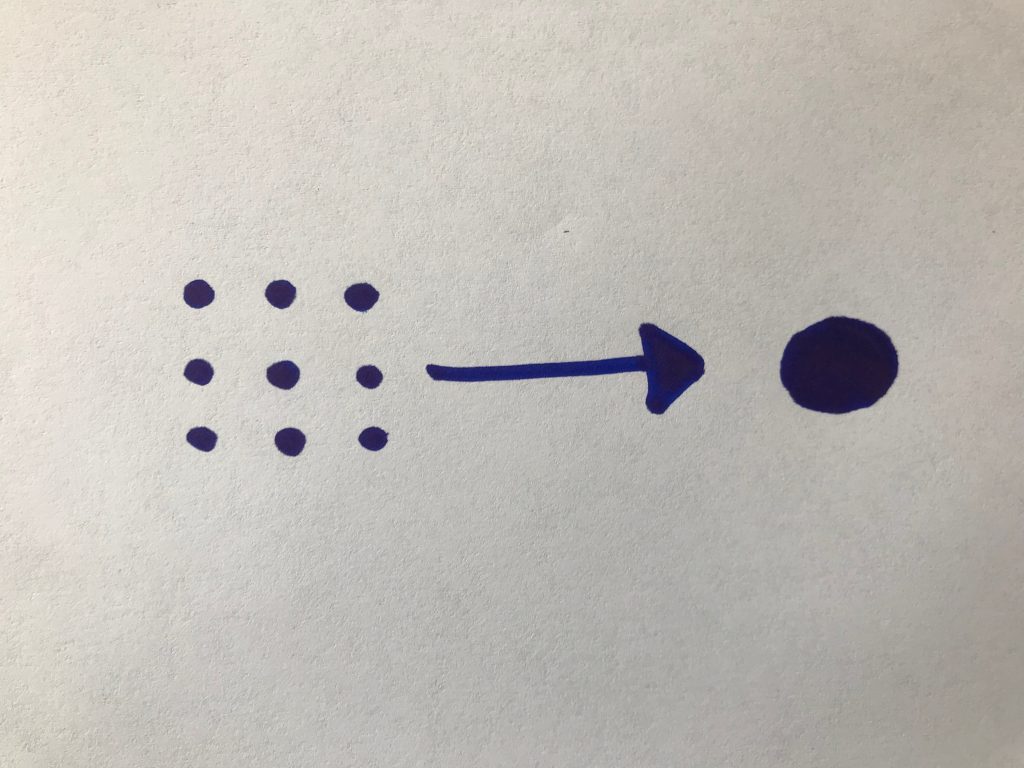
By Rob Assise, Homewood-Flossmoor High School
I started my track and field coaching career at Homewood-Flossmoor High School in 2004. Twenty-two years old, eight months out of college, and inheriting a successful girl’s sprint program. Adia McKinnon (class of 2000) was a name fresh in everyone’s mind. She remains one of the greatest female sprinters in Illinois history (15-time all-state, including nine state championships), and was a huge part of H-F’s dominance in the 800 m Medley Relay (one runner-up and three state titles from 1997-2000).
My hope heading in was to build a sprint program which could compete at an elite level year after year. I thought the best way to judge the health of one was performance in the sprint relays. I still believe that. Although relay performance is bolstered by elite athletes, four non-elites can still produce state-qualifying (and even state-finalist) performances.
Like any young coach, I thought I knew more than I did, and based what we did off of the way I was coached. In college, my primary events were the javelin, 400 m, and high jump. I also triple jumped and ran the 200 m periodically. The training I went through for the 400 m had some high volume pieces to it, and it worked well for me. Naturally, I figured it would work well for my sprinters.
Reflecting upon our performance at the end of the season, I thought it did. We took 5th in the 800 m medley and 4×400 m relays. I also felt we had state-qualifying caliber 4×100 m and 4×200 m relays, but our sectional was held in less than ideal situations (rain and temperatures in the low-40’s). Our 4×100, which had been consistently under 50 seconds (and ran 49.2 the week before), ran 51.09 at sectionals. Our 4×200 was also consistently well under state qualifying time leading up to sectionals, but was unable to advance on time. To this day, I think our state’s system for state qualification is flawed and the coaches of our sectional suggest changes to the advisory committee each year.
Fast forward to 2005. We had some major pieces returning headlined by seniors Seun Adigun and Deserea Brown. You may be familiar with Seun. She recently represented Nigeria in the Winter Olympics in the bobsled. Prior to bobsledding, Seun represented Nigeria in the 100 m hurdles in the 2012 Summer Olympics. Her collegiate career included being an All-American at the University of Houston.
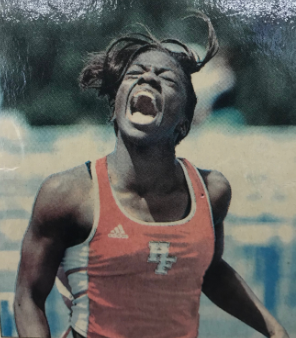
Seun Adigun finishing the 100 m Hurdles at the 2005 IHSA State Meet. She was 2nd to former teammate and Illinois great Shalina Clarke.
Deserea was a 16-time All-American at Southern Illinois University-Edwardsville before they moved to the Division 1 level. Prior to her senior year, she transferred to the University of Illinois and was an All-American in the 400 m Hurdles. Both ladies competed at the 2008 Olympic Trials.

Deserea Brown closing out the 2005 IHSA State Meet with a victory in the 4×400 m Relay. To this day, Seun and Deserea are the most intense competitors I have ever coached.
We rolled through the 2005 season with our sights set on a team trophy. We knew the best we could do was 3rd (at that point in time Evanston and Morgan Park were absolutely ridiculous). Completing a workout structure which was based around volume, we had an incredible season. We qualified all four sprint relays to the state meet. Our focus shifted a bit from the previous year and we put our best sprinters (Brown and Adigun) in the 4×100 instead of the medley. With the medley being the first event, it would not be ideal for those two to run a 200 and 400 prior to their individual events (Adigun 100H/300H, Brown 100/400).
Our 4×100 took 2nd (48.07) despite a terrible 1st exchange. Our outgoing runner (Kayla Cole) came to a complete stop to get the stick in the zone from our lead-off leg (Lisa Brooks, who always ran a phenomenal first leg). It was the first poor exchange those two had in two seasons. Such is life when batons are involved. If that exchange was even below average, I think they would have been state champions. That being said, once Cole received the stick, she was shot out of a cannon and kept us in it, and the way Brown and Adigun closed the deficit is one of the most remarkable things I have witnessed in any sport.
Our 4×400 won the state title. Adigun put us in the lead kicking things off with a 56.4. Erica Curry did her job getting the stick around in 61.01, but there were a handful of teams jockeying for the top spot after the 2nd exchange. Sophomore Jasmin Clark exploded out of the pack on the back stretch and held the lead into the final exchange with a 57.89 split. From that point it was pretty much in the bag. Brown ran a blistering 55.23 split even though she was never challenged. Their final time of 3:50.50 exceed my expectations.
The girls knew prior to the relay that if they beat Palatine, we would achieve our team goal of 3rd in the state. Palatine ended up being runner-up in the relay. We took 3rd as a team with 46 points behind Evanston (87) and Morgan Park (71). An additional twist to the story is Adigun transferred to H-F from Evanston after her sophomore year. If Seun had stayed at Evanston, a conservative estimate of additional points Evanston could have earned is 22, which would have put them at 109. Insane.
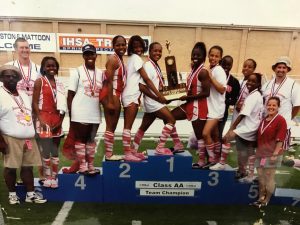
Our 3rd Place IHSA Class 2A Team. I heard someone say the happiest people at the Olympics are the gold and bronze medal winners and the saddest are the silver medalists. That was the case on this day (although we may have been even happier than Evanston). It was also true at the end of this past season (2018) where the HF Boys’ Team (which I am currently an assistant) placed 2nd.
Inside the Individual Numbers
While relays serve as a monitor of program health, individual progress must be analyzed to determine training program effectiveness. Here is a look at the progress of Brown and Adigun from 2004 to 2005.
Deserea Brown – 400 m Dash
- 2004
-
- 60.53 in the bad weather sectional and did not qualify for state. Was consistently under 60 seconds during outdoor.
- 2005
- 55.23 (state finals) and was runner-up to Morgan Park’s Alexandria Anderson.
Seun Adigun 100H (2004 & 2005), 400 (2004), 300 H (2005)
- 100 H
- 2004 – 16.11 in the bad weather sectional. Consistently in the mid-15’s during outdoor.
- 2005 – 14.19 (state finals). Runner up to Evanston’s Shalina Clarke.
- 400
- 2004 – 56.83 (state finals). 5th place.
- 300H
- 300 H – 43.86 (state finals). Runner up to Evanston’s Shalina Clarke.
When most people look at these numbers, they would think we did a good job of setting them up with a template where they could succeed. Both runners had substantial drops in both their individual events and relay splits. When I look at them, and know what was behind them, I shake my head and wonder what could have been.
Here is an example. In 2004, Deserea competed in the 800 m Medley (400 m leg), the open 400 m, the 4×400 m, and the high jump…..in almost EVERY outdoor invite. She even had the ability to convince me that she should do it during our weekday duals a couple times. Her logic was that it would prepare her for invites. Yes folks, this represents the high point of my stupidity on this planet. It was what she had done the year prior as a sophomore, and even though I was not completely comfortable with it, I let it happen. It is ultimately what held her back in the open 400 in 2004.
I recently looked at our training plan for 2004. Here is a sample from week two of our outdoor season (early April).
Monday
- Intensive Tempo
- 100/200: 2 x 100, 150, 200, 250, 1 x 200 @ 80% of best 200 (rest 2 min / rep, 4 min / set)
- Add ~1 second for 250 target time
- 400 – 2 x 300, 400, 500 @ 80% of best 400 (rest 2.5 min / rep, 5 min / set)
- Add 2-3 seconds for 500 target time
- 100/200: 2 x 100, 150, 200, 250, 1 x 200 @ 80% of best 200 (rest 2 min / rep, 4 min / set)
- Weightroom
Tuesday
- Speed
- ALL – Plyos
- ALL – 3 x 40 m (rest 4 minutes)
- Relay Athletes – exchanges
- Non Relay Athletes – additional 3 x 40 m
- Specialties
Wednesday
- Dual Meet
Thursday
- 5 x extensive tempo diagonals @ 70% (run diagonal of football field, walk the width, and run the other diagonal)
- Weightroom
Friday
- Meet Prep (blocks, handoffs, approaches)
Saturday
- Invite
I say this often: You can almost do anything in training with a high school athlete and they will get better. Due to the low training and chronological age, their bodies will adapt to any stimulus they face. I look back now and think that Deserea and Seun did not get better because of me, they became better in spite of me.
The scariest part of coaching high school athletes is you can train your athletes in a manner which is far from ideal and still have success. The success then perpetuates your belief in your faulty system. This applied to me after the 2005 season.
With Brown and Adigun moving onto college, expectations were not as high heading into 2006. However, we were still able to qualify all four sprint relays again, and ended up all-state in the 4×100, 4×200, and 4×400. These results furthered my belief in a faulty system. If we could get three all-state relays without an individual finalist in a sprint event, we had to be doing things the right way.
In 2007 and 2008, we qualified all three sprint relays (the medley was no longer part of the girl’s program), but none of them advanced to the finals. We also had seven individual event qualifiers between the two years, however only long jumper Jasmin Clark advanced to finals.
I felt we had finalist-caliber 4×100 and 4×200 relays in 2008, but we were disqualified in both in the prelims. That year our outdoor stadium was being redone, so to practice on an outdoor track we had to head to Bloom Trail (a 25 minute drive) two times per week. We had zero issues with exchanges leading up to the state prelims. Unfortunately, we were unable to get the stick around successfully when it counted most. Such is life when batons are involved.
The Shift Begins
The results of 2007 and 2008 had me questioning our methods more than I had in the past. While I knew there were components of our programming which were solid, I began wondering if there were alterations which would be beneficial. Over the next seven years we progressively did less volume, but still found a tremendous amount of success. From 2009-2014 our athletes accomplished the following:
| Event / Year | 2009 | 2010 | 2011 | 2012 | 2013 | 2014 |
| 4×100 m Relay | 4th | 2nd | 4th | 3rd* | 3rd | 3rd |
| 4×200 m Relay | Q | 2nd | 9th** | 5th* | 5th | 4th |
| Sprint-Based Individual Events | 25 state qualifiers
16 all-state athletes (including 5 runner-ups and 2 state champions) |
|||||
The “Q” in the 2009 4×200 means we qualified for state, but did not make it to finals.
The * in the 2012 4×100 and 4×200 denote that we had to use different combinations of runners in prelims and finals due to two different injuries. To place as high as our athletes did in both relays is one of the things I was most proud of during my tenure as girl’s coach. They did not flinch when faced with adversity. It also shows that being an alternate matters!
The ** in the 2011 4×200 signifies a dropped baton. Our girls still ran 1:43.95. I think we would have ran under 1:40 and finished no worse than 2nd in the relay with decent exchanges. To add further salt to the injury, we would have placed 2nd as a team had we finished 6th or higher in the 4×200. We ended up with a team finish of 4th, just missing a trophy (3rd place) by one point. Such is life when batons are involved.
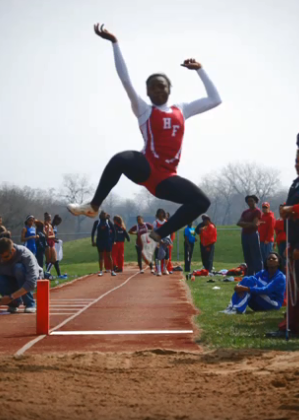
The 2011 squad was led by Abie Ehimwenman, State Champion in the LJ and TJ and 4th in the 200.
2015 was my last season with our girl’s program. Despite two key outgoing transfers over the previous two seasons, we still had a group that could contend for a state trophy. We qualified nine entrants to the state meet. Unfortunately, we were not able to put our best quartets on the track in the 4×100 and 4×200 at the state meet due to a discipline issue and a parent issue. I will not disclose the discipline issue, but the parent issue is one worth sharing.
After sectionals, our staff and the athletes in the 4×100 met to discuss changing the order. It was something I was not ecstatic about, but I did think it would allow us to go faster. By the end of the meeting, our athletes and coaches were comfortable with the change. A parent of one of the girls was not. She did not let her daughter come to practice the entire week leading up to the state meet and did not even allow her to travel with the team. We were unable to practice the new order, so we had to keep it the same. Some may wonder why we would allow the athlete to compete. The reason was the parent was the main issue, not her daughter. Furthermore, the drop-off after our top four sprinters was substantial, and making a substitution would jeopardize the chance of the other athletes involved to be part of an all-state relay. It was a unique and unfortunate situation where the parent had control, and she exploited it at the expense of others involved. I have reflected back numerous times on how to handle this situation if given another chance, and the only conclusion I can make with confidence is that no answer is 100% correct.
Neither relay advanced to finals. Our 4×200 was lower-end state-finalist caliber. Our 4×100 was state-champion caliber. I thought they would be the first relay in school history to break 47 seconds. Although it was a crazy week, it did end on a high note. Jayla Stewart had an incredible state final day, winning the 100 m Hurdles, and finishing 2nd in the 100 and 200.
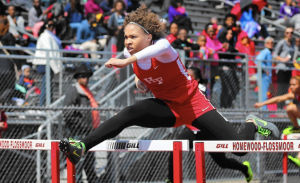
Jayla Stewart in the 100 m Hurdles during her phenomenal senior campaign. She was also my first Reflexive Performance Reset (RPR) “test subject.” More about that can be found here.
Here is the backstory to these results:
- Based on the athletes we had returning in 2009, we shifted away from focusing training around the 400 meters. We had athletes whose primary events would be the 100 and 200, so we made max velocity the priority. As the years went on, we continued to go further down that route because we saw that the speed focused training still improved the 400 m times of our elite 100 m and 200 m sprinters when they ran the 400 m. By 2010, we did not have separate running workouts for 100/200 and 200/400 runners.
- At the start of my coaching career, I spent a lot of time selling workouts (such as the intensive tempo workouts mentioned earlier). I think I became excellent at it, but my measure of success was that half of our 40 sprinters would have great intent throughout the workout. So a good day included 20 sprinters walking off the track with not meeting the desired objective. Although the standard school grading scale has flaws, it is appropriate in this scenario: 50% is failing.
- As the volume decreased, the intensity increased organically. Even though we were still doing “80% workouts,” everyone’s 80% was faster because the volume was lower (1000 m – 1200 m versus 1800 m – 2000 m).
- Because the intensity was higher, we noticed that our sprinters actually looked more like sprinters during our intensive tempo workouts. This was transformative for not only the athletes, but our coaching staff as well. Seriously, what the hell did I expect when I asked a high school athlete to run 500 meters at 80% after running a 300 and 400? If you coach sprinters, and you see anything which resembles a death march, stop the workout and apologize to your athletes….twice.
- We noticed that with the volume decreasing and the intensity increasing we had a significant decrease in nagging injuries such as shin splints.
- As time went on, the volume continued to fall, and the intensity continued to rise. Our lactate workouts eventually went down to 400 m – 800 m of total volume with intensity being 90% or higher. Seeing Chris Korfist present and reading Tony Holler’s early work bolstered my belief that I was on a legitimate path.
- Most importantly, the intent athletes had on our lactate days increased exponentially. We progressively improved from 50% having great intent throughout to 90+%.
- Some may wonder what happened to our 4×400 m Relays. During the majority of the years, we had the ability to put together quartets which could go under 4 minutes, but we did not have the depth needed to do this along with running our state-finalist caliber athletes in the 200.
What Does All This Mean?
Well, more than anything, if you are a young coach, your stupid phase can be a lot shorter than mine. After reading through all of this, these are my big takeaways:
- Always question why you are doing something. If you cannot provide a detailed answer that aligns with your primary objectives, get rid of it! In the words of Greg McKeown, author of the book Essentialism: The Disciplined Pursuit of Less, “If the answer isn’t a clear yes, then it is a clear no.”
- Always look for a better way to do things. The times I get the most excited are when I find something I can add to our program, and the addition allows me to take away two or more other items!
- If you coach anything from the 400 on down, structure training around maximum velocity days. It brings everything else up with it. This is non-negotiable.
- I think lactate days allow for more flexibility. These types of workouts are a mental and physical challenge. I believe they can be aligned for the workout objective as well as the athlete’s physical strengths and mental make-up to work in harmony. For example:
- Watered-Down Workout Objective: Acidosis (get the legs burning)
- Workout Options
- 2 x 23 second runs (10 minutes rest)
- Cover as much distance as possible in 23 seconds. Try to match first distance.
- 3 x (4 x 40 m) @ 100% (Rest 1 minute per rep, 5 minutes per set)
- 3 – 4 x 120 m @ 97% (3 minutes rest)
- Athletes accelerate up to a feeling of 97% and hold.
- 5 x 200 m @ 82.5% (Rest ~ 3 minutes)
- 5% of best 200 meter time. Found by 200 PR / .825
- 2 x 23 second runs (10 minutes rest)
- These are different approaches to reach essentially the same objective. Sure, we could all argue what we prefer, when we think each is appropriate during the season, or what we think achieves the objective the best, but what we really should base our decision making on is the following:
- What will the INVDIVIDUAL respond best to on this particular day?
- What am I best at selling so the athlete believes in the workout and gives maximal intent?
- Maybe the answer lies in allowing providing options and allowing the individual to become part of the decision making process.
When I began writing this, the initial title was “Feeding the Cats the H-F Way.” I was going to discuss how we structure our acceleration and maximum velocity workouts. I thought I would go into a brief history behind how I evolved to my current beliefs. 3500+ words later, I still have yet to get to my original purpose. Ironic considering the title of the article. Even more ironic since people who I meet in person openly wonder if I am mute. Apparently, there was a story within me to tell that I did not know was there to be told. I will get to my initial purpose soon, but there is no doubt that this trip down memory lane was valuable for me. Maybe the best way to a brighter future is through the past.
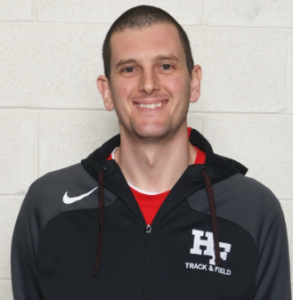
Rob Assise has 15 years of experience teaching mathematics and coaching track and field at Homewood-Flossmoor High School. He also has coached football and cross country. Rob has attended all seven Track-Football Consortiums and was a presenter at TFC-6 and TFC-7. Additional writing of his can be found at Simplifaster, Just Fly Sports, and ITCCCA. He can be reached via e-mail at robertassise@gmail.com or Twitter @HFJumps.

“It’s What You Learn after You Know it All that Counts the Most”
John Wooden😊